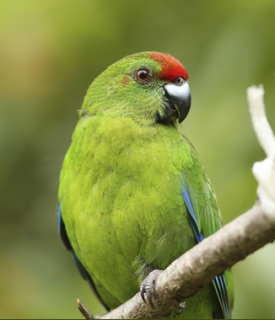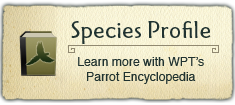Project Regions:
Tasman Parakeet |
|
|
Collaborators/Funders
Massey University, Parks Australia, the Australian Department of Environment, the Foundation for National Parks and Wildlife, the Parrot Trust of Australia, the Parrot Society of Australia, BirdLife Australia, Island Conservation, the Nature Conservancy, the Parrot Society of the UK, the Mohamed bin Zayed Species Conservation Fund, Massey University and Wildmob.
Critically Endangered parakeet on the edge of extinction
The Tasman Parakeet's (Cyanoramphus cookii) numbers are dangerously low.
Progress and outcomes: Since 2013 WPT has been supporting conservation work aimed at preserving the last of the Tasman Parakeets in Norfolk Island National Park. The Trust supported the early stages of the project by funding two GPS units to link to satellites from the deep valleys where some of the parrots are located. Parakeet researcher Dr. Luis Ortiz-Catedral and team conducted surveys that found no more than a dozen breeding females. To monitor breeding activity three motion-sensitive cameras were installed at different nest sites. Through mid-2014 of the breeding season 51 chicks had fledged, half of them female.
Focus of future work: Conservation actions have included control of introduced mammals and birds to minimize disturbance to females while nesting, and the development of a translocation strategy to Phillip Island. By 2014, there were 78 predator-resistant nest sites, with 11 active nests. By March of 2017 at least 17 females were on active nests. The team has launched education and awareness programs to reach over 2,000 people, stressing the importance of protecting nests, keeping feral predators away from the parrots’ nesting areas, and promoting native plant propagation, all with good success. Recently, the WPT submitted a statement to IUCN regarding the taxonomic treatment of New Zealand parakeets including Tasman, New Caledonian, Red-crowned and Reichek’s. Reassignment of these birds as separate species would have positive ramifications for their conservation and management.
With your help we can increase efforts to better understand the species and continue to deliver effective solutions to further their conservation.
Wild population: Fewer than 100 mature individuals
Where found: Norfolk Island (between Australia, New Zealand and New Caledonia)
History: The Norfolk Island Parakeet, or Cyanoramphus cookii, is native to Norfolk Island. It was formerly found around the entire island but is now scattered in remnant forest patches in Norfolk Island National Park. It was once estimated to number at least 190 pairs. By 1994 the population had dwindled to only four breeding females and about 30 males. After a round of intensive conservation actions the population grew to just under 300 birds, but then dropped again to 150-200 in 2008. The population is declining yet again from an estimated population of 240 birds in 2010. It is now estimated at fewer than 100 mature individuals.
Threats:
- Clearance of forests before 1950 for timber, agriculture and pasture
- Non-native plant invasion, altering the remaining native vegetation
- Loss of nest sites due to competition from Crimson Rosella, Common starling and honey bees
- Nest failures from predation by introduced Black rats
- Predation by feral cats
- Sex ratio biased towards males
Ecology: The Norfolk Parakeet is confined to the Norfolk Island National Park and adjacent forested areas and orchards. Birds take a variety of fruits, shoots, blossoms and shrub seeds. They also feed on introduced olives Olea africana.
Project Updates
WPT-sponsored research:
Foraging ecology of the world's only population of the critically endangered Tasman Parakeet...
Other Publications:
The Norfolk Island Parakeet and New Caledonian Red-crowned Parakeet are distinct species
Google scholar - Cyanoramphus cookii


































